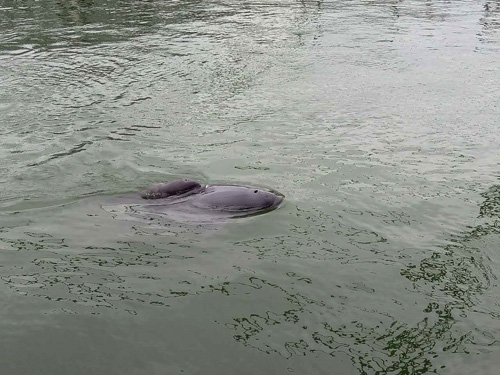
Newsroom
First Caged Yangtze Finless Porpoise Gives Birth to a Newborn in Tian-E-Zhou Reserve

A caged Yangtze finless porpoise gave birth to a newborn in Tian-E-Zhou Reserve at 3:30 a.m. on May 22, 2016. (Image by IHB)
“E E”, a female Yangtze finless porpoise, gave birth to a newborn at 3: 30 a.m. on May 22nd, 2016, in a floating net cage located in the Tian-E-Zhou Baiji National Natural Reserve, proving to be the first successful breeding of caged Yangtze finless porpoises in natural waters.
The 10-year-old new Mom “E E” was rescued during the ice disaster in 2008, and then transferred to net cage in Tian-E-Zhou Reserve. “E E” was pregnant in 2013 and 2014 respectively, but both failed due to a series of environmental factors. Fortunately, on May 11st last year, the staff in the reserve estimated that “E E” was probably pregnant again according to her serum progesterone tests results. On June 28th, her pregnancy was further confirmed by ultrasound imaging.
The staff in Tian-E-Zhou Reserve, together with researchers from Institute of Hydrobiology of the Chinese Academy of Sciences (IHB), has taken all kinds of measures, including nutrition formulation, water temperature regulation, water quality improvement to ensure her successful pregnancy and childbirth. With joint efforts, her first new baby was born after more than one year.
On the early morning of the May 22nd, the fetus’ tail fin was able to be seen out of “E E’s” vagina. Two hours and 10 minutes later, the new baby swam out of the water surface for its first breath. “E E” is a first-time mother, but she is very kind and experienced. She began to look after her new baby right after the childbirth. Since the new baby had no sense of direction at first, “E E” tried to lift her baby and helped it swim and breathe normally. One hour later, the calf could swim with its mom smoothly. At 8:30 a.m. the staff observed a clear breast feeding behavior. According to the staff in Tian-E-Zhou reserve, the mother and the calf were both doing well until now.
HAO Yujiang, PhD at IHB said “E E” and her baby have gone through three critical periods: delivery, nurturing and nursing. The baby will grow stronger, so does its survival ability. However, the new baby will face a special challenge within one week after its birth -- the “molting” period. Besides, if the water quality is not good enough, the calf is likely to be at risk of skin infections. Three months later, the breast-fed calf will turn to eat some fish, its digestive system will face another challenge.
Now the new baby is enjoying this mysterious world, and meanwhile facing various threats from this unknown world. The new life represents the hope of Yangtze finless porpoise population. Wish this new baby and all the Yangtze finless porpoises a good future.